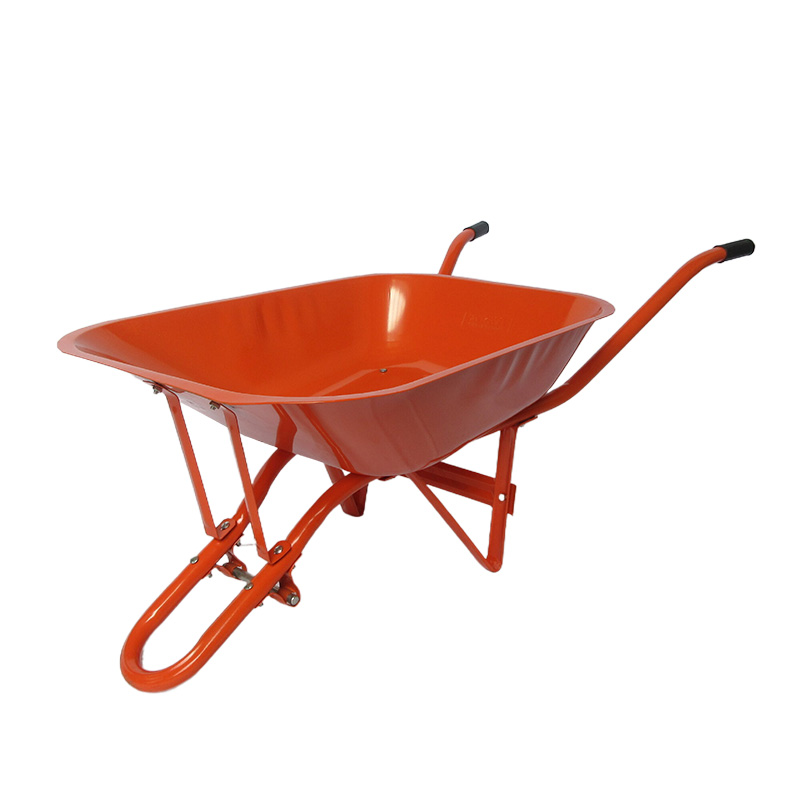- All
- Product Name
- Product Keyword
- Product Model
- Product Summary
- Product Description
- Multi Field Search
Please Choose Your Language
Views: 0 Author: Site Editor Publish Time: 2025-07-07 Origin: Site









The wheelbarrow, a simple yet revolutionary tool, has been essential in construction, agriculture, and more. Over centuries, it has evolved from a basic cart to a modern engineering marvel.
In this post, QINGDAO YONGYI METAL PRODUCTS CO., LTD’ll explore the wheelbarrow’s fascinating history, from its early Chinese origins to the latest innovations shaping today’s designs.
The earliest evidence of the wheelbarrow in ancient China dates back to the 1st and 2nd centuries. It was initially made of wood, and its primary function was transporting food, supplies, and other goods over short distances. These early wheelbarrows were essential for daily activities, especially in agricultural settings, where they helped move crops and materials more efficiently than carrying them by hand.
Interestingly, wheelbarrows were also used in military contexts. They played a crucial role in transporting wounded soldiers, enabling faster evacuation from battlefields. This military usage showcased the potential of the wheelbarrow for large-scale logistics, marking its first major step toward versatility.
In 231 CE, Zhuge Liang, a prominent Chinese military strategist, revolutionized the design of the wheelbarrow. He introduced the idea of a centrally mounted wheel, which greatly enhanced the stability of the vehicle. This innovation allowed a single person to carry larger loads, making it more practical for various applications, including both civilian and military use.
Zhuge Liang’s improvement, often referred to as the "wooden ox," became vital in wartime logistics. It allowed for the transport of supplies, weapons, and even wounded soldiers, providing the military with a significant advantage. The "wooden ox" was particularly useful in the supply chain, reducing the number of people needed for these tasks and making operations more efficient.
The wheelbarrow spread to Europe during the 12th and 13th centuries. It quickly adapted for use in agriculture, helping to transport crops, livestock, and goods. In European settings, the design evolved slightly to fit different needs. While the basic principle of a single wheelbarrow remained the same, Europeans started modifying it to cater to their agricultural environment.
The arrival of the wheelbarrow in Europe marked a significant shift in farming efficiency. With its help, European farmers were able to move heavy loads like hay, grain, and even soil much more easily than before. Interestingly, the European designs often featured more durable materials, such as iron, compared to the wooden models used in China.
As the wheelbarrow became more common in Europe, different regions began to design their own variations. In France, for example, wheelbarrows often featured solid wheels, while in the Netherlands and Switzerland, spoked wheels became more common. These variations were tailored to meet the needs of specific industries like construction, mining, and agriculture.
Region | Design Features | Uses |
France | Solid wheels | Agriculture, construction |
Netherlands | Spoked wheels | Mining, agriculture |
Switzerland | Four feet design | Construction, heavy lifting |
These regional differences were essential in how the wheelbarrow was utilized. In France, the solid wheels were ideal for transporting materials across flat, hard surfaces, while the spoked wheels in the Netherlands were perfect for rougher terrains like farms and mines.

The 19th century saw significant changes in wheelbarrow materials. As industries began to grow, the demand for more durable and efficient wheelbarrows increased. This led to the shift from wood to metal frames, which improved the overall strength and longevity of the wheelbarrow. Additionally, the designs started to evolve with rounded edges, making them safer and easier to use.
Another major innovation during this period was the introduction of better wheel designs, including rubber and steel wheels. These new wheels made the wheelbarrow more maneuverable and capable of handling heavier loads. The industrial revolution also saw wheelbarrows used for transporting larger materials, including bricks and coal, for construction projects.
During World War I, the wheelbarrow became an essential tool for transporting supplies, ammunition, and wounded soldiers. Its versatility made it invaluable, especially in the field, where mechanized vehicles were not always available. The design of the wheelbarrow played a key role in supporting soldiers during the war, ensuring that supplies were transported quickly and efficiently.
However, by World War II, mechanized vehicles began to replace the wheelbarrow in larger operations. Despite this, the wheelbarrow continued to be used in smaller-scale logistics, particularly for medical support and in areas where larger vehicles could not reach.
The post-war era brought about many changes to the wheelbarrow, primarily in terms of materials and design. In the 1950s, wheelbarrows began to incorporate cast steel frames and rubber wheels. These materials made the wheelbarrow more durable and easier to maneuver, especially in outdoor and construction environments.
Alongside these innovations, manufacturers began using polythene for the buckets, making them lighter and more resistant to wear. There was also an improvement in the tire designs, with wider tires being introduced to help distribute weight more evenly and reduce the risk of punctures. These changes made the wheelbarrow even more efficient and practical for a wider range of tasks.
In the 1970s, James Dyson introduced a revolutionary new design known as the Ballbarrow. This design featured a spherical wheel, which provided better stability and maneuverability compared to traditional wheels. The Ballbarrow was especially useful in tight spaces, where a traditional wheelbarrow would struggle to move.
Today, the wheelbarrow continues to evolve. Modern designs incorporate multiple wheels, such as the tri-wheel model, which distributes the weight evenly and makes it easier to carry heavier loads. Advanced materials, like carbon fiber and lightweight alloys, are used to make wheelbarrows more durable and easier to handle.

Today, there are various types of wheelbarrows, each designed for specific tasks. These include:
● Galvanized Wheelbarrows: Known for their durability, these are ideal for heavy-duty tasks like construction and gardening.
● Pneumatic Wheelbarrows: These have air-filled tires, which provide a smoother ride over rough terrain.
● Puncture-Proof Wheelbarrows: Featuring solid rubber tires, these wheelbarrows are perfect for environments where punctures are a concern.
Type | Features | Best For |
Galvanized | Durable, rust-resistant | Heavy-duty tasks |
Pneumatic | Air-filled tires, smooth ride | Rough terrain, construction |
Puncture-Proof | Solid rubber tires | Environments with puncture risks |
Each type has its advantages depending on the task at hand. For instance, pneumatic wheelbarrows are best suited for construction sites where rough terrain is common, while galvanized models are more suitable for gardening and carrying heavy materials.
Modern wheelbarrows are designed with durability and minimal maintenance in mind. Manufacturers are increasingly using eco-friendly materials and designs that reduce the environmental impact. For example, the use of recycled materials in wheelbarrow construction is becoming more common, and manufacturers are also exploring ways to reduce the carbon footprint of production.
Additionally, the role of wheelbarrows in various industries, including gardening, construction, and farming, continues to evolve. Wheelbarrows are used to transport everything from soil to bricks and even plants. With better materials, modern designs have become more ergonomic, reducing strain on the user and increasing efficiency in various tasks.
The wheelbarrow has evolved from a simple wooden tool in ancient China to a highly efficient vehicle used worldwide. Its design improvements, from Zhuge Liang’s innovations to modern adaptations, reflect its enduring relevance. Today, wheelbarrows continue to play a crucial role in industries like construction and agriculture. As new materials and designs emerge, the wheelbarrow will likely see further innovations, making it even more efficient and versatile for future needs.
A: The wheelbarrow originated in ancient China during the 1st-2nd century. It evolved across cultures, with Zhuge Liang's design improvements enhancing its functionality, especially in military logistics.
A: During World War I, the wheelbarrow played a key role in transporting supplies, ammunition, and wounded soldiers, providing essential support in logistics where vehicles were limited.
A: Modern wheelbarrows are made from materials like metal, plastic, and rubber. These materials offer durability, resistance to corrosion, and smooth maneuverability, enhancing overall performance.
A: Yes, there are various types, including garden, construction, and pneumatic wheelbarrows. Each is designed for specific tasks, such as handling heavy loads or rough terrains.
A: Wheelbarrows have evolved from simple wooden designs to advanced models like the Ballbarrow, featuring spherical wheels for improved stability and maneuverability in tight spaces.